ECO mode MAZDA MODEL 3 HATCHBACK 2010 Owner's Manual (in English)
[x] Cancel search | Manufacturer: MAZDA, Model Year: 2010, Model line: MODEL 3 HATCHBACK, Model: MAZDA MODEL 3 HATCHBACK 2010Pages: 488, PDF Size: 6.52 MB
Page 2 of 488
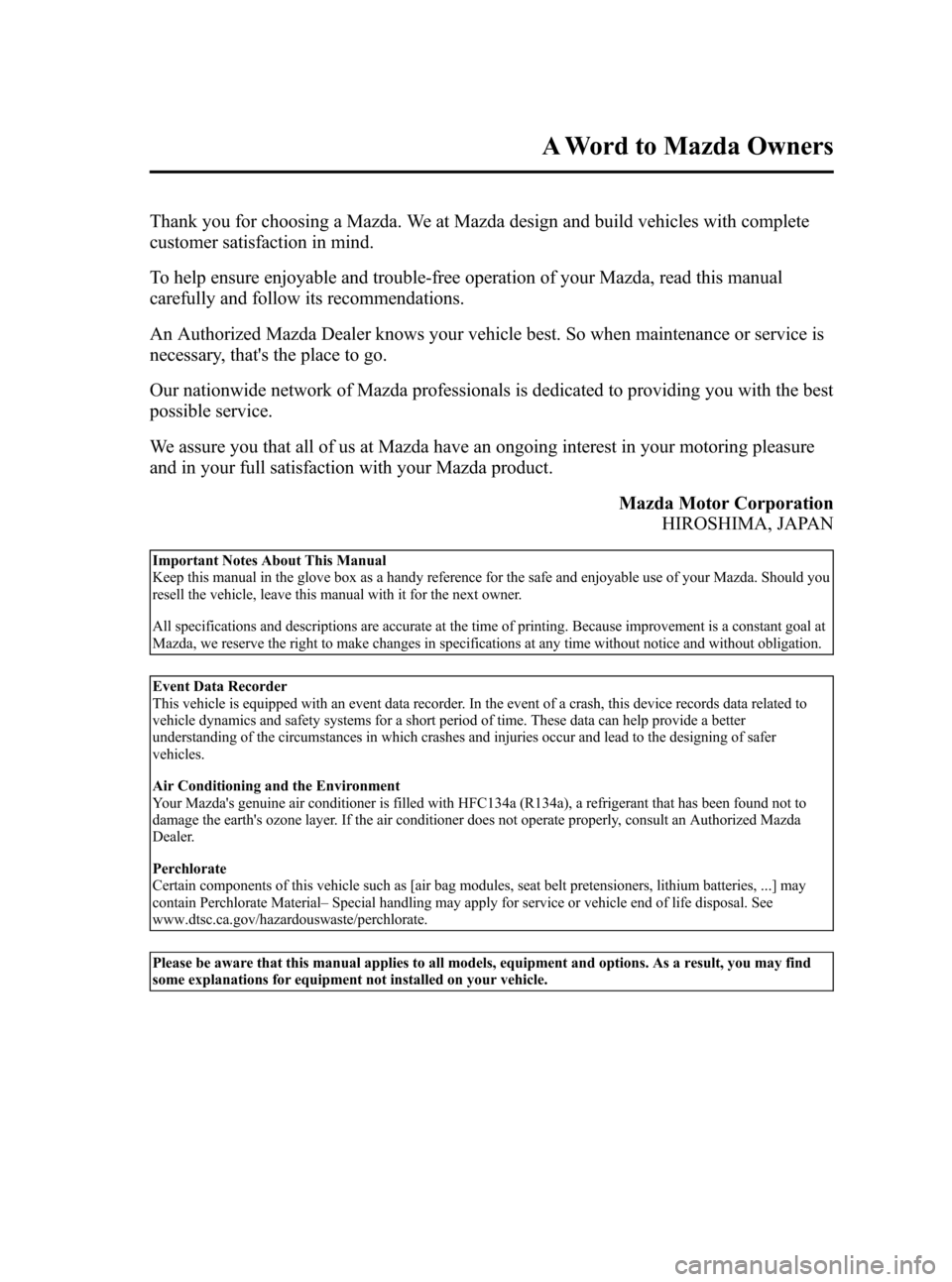
Black plate (3,1)
Thank you for choosing a Mazda. We at Mazda design and build vehicles with complete
customer satisfaction in mind.
To help ensure enjoyable and trouble-free operation of your Mazda, read this manual
carefully and follow its recommendations.
An Authorized Mazda Dealer knows your vehicle best. So when maintenance or service is
necessary, that's the place to go.
Our nationwide network of Mazda professionals is dedicated to providing you with the best
possible service.
We assure you that all of us at Mazda have an ongoing interest in your motoring pleasure
and in your full satisfaction with your Mazda product.
Mazda Motor Corporation
HIROSHIMA, JAPAN
Important Notes About This Manual
Keep this manual in the glove box as a handy reference for the safe and enjoyable use of your Mazda. Should you
resell the vehicle, leave this manual with it for the next owner.
All specifications and descriptions are accurate at the time of printing. Because improvement is a constant goal at
Mazda, we reserve the right to make changes in specifications at any time without notice and without obligation.
Event Data Recorder
This vehicle is equipped with an event data recorder. In the event of a crash, this device records data related to
vehicle dynamics and safety systems for a short period of time. These data can help provide a better
understanding of the circumstances in which crashes and injuries occur and lead to the designing of safer
vehicles.
Air Conditioning and the Environment
Your Mazda's genuine air conditioner is filled with HFC134a (R134a), a refrigerant that has been found not to
damage the earth's ozone layer. If the air conditioner does not operate properly, consult an Authorized Mazda
Dealer.
Perchlorate
Certain components of this vehicle such as [air bag modules, seat belt pretensioners, lithium batteries, ...] may
contain Perchlorate Material–Special handling may apply for service or vehicle end of life disposal. See
www.dtsc.ca.gov/hazardouswaste/perchlorate.
Please be aware that this manual applies to all models, equipment and options. As a result, you may find
some explanations for equipment not installed on your vehicle.
©2009 Mazda Motor Corporation
Printed in Japan Jan. 2009(Print1)
A Word to Mazda Owners
Mazda3_8AD6-EC-09A_Edition1 Page3
Tuesday, December 2 2008 2:26 PM
Form No.8AD6-EC-09A
Page 28 of 488

Black plate (30,1)
Seat Belt Precautions
Seat belts help to decrease the possibility of severe injury during accidents and sudden
stops. Mazda recommends that the driver and all passengers always wear seat belts.
All of the seat belt retractors are designed to keep the lap/shoulder belts out of the way
when not in use.
The driver's seat belt has no provisions for child-restraint systems and has only an
emergency locking mode. The driver may wear it comfortably, and it will lock during a
collision.
However, the front passenger's seat and all rear lap/shoulder belt retractors operate in two
modes: emergency locking mode, and for child-restraint systems, automatic locking mode.
While we recommend you put all children in the rear seats, if you must use the front
passenger seat for a child, slide the front passenger seat as far back as possible and make
sure any child-restraint system is secured properly.
2-16
Essential Safety Equipment
Seat Belt Systems
Mazda3_8AD6-EC-09A_Edition1 Page30
Tuesday, December 2 2008 2:26 PM
Form No.8AD6-EC-09A
Page 30 of 488
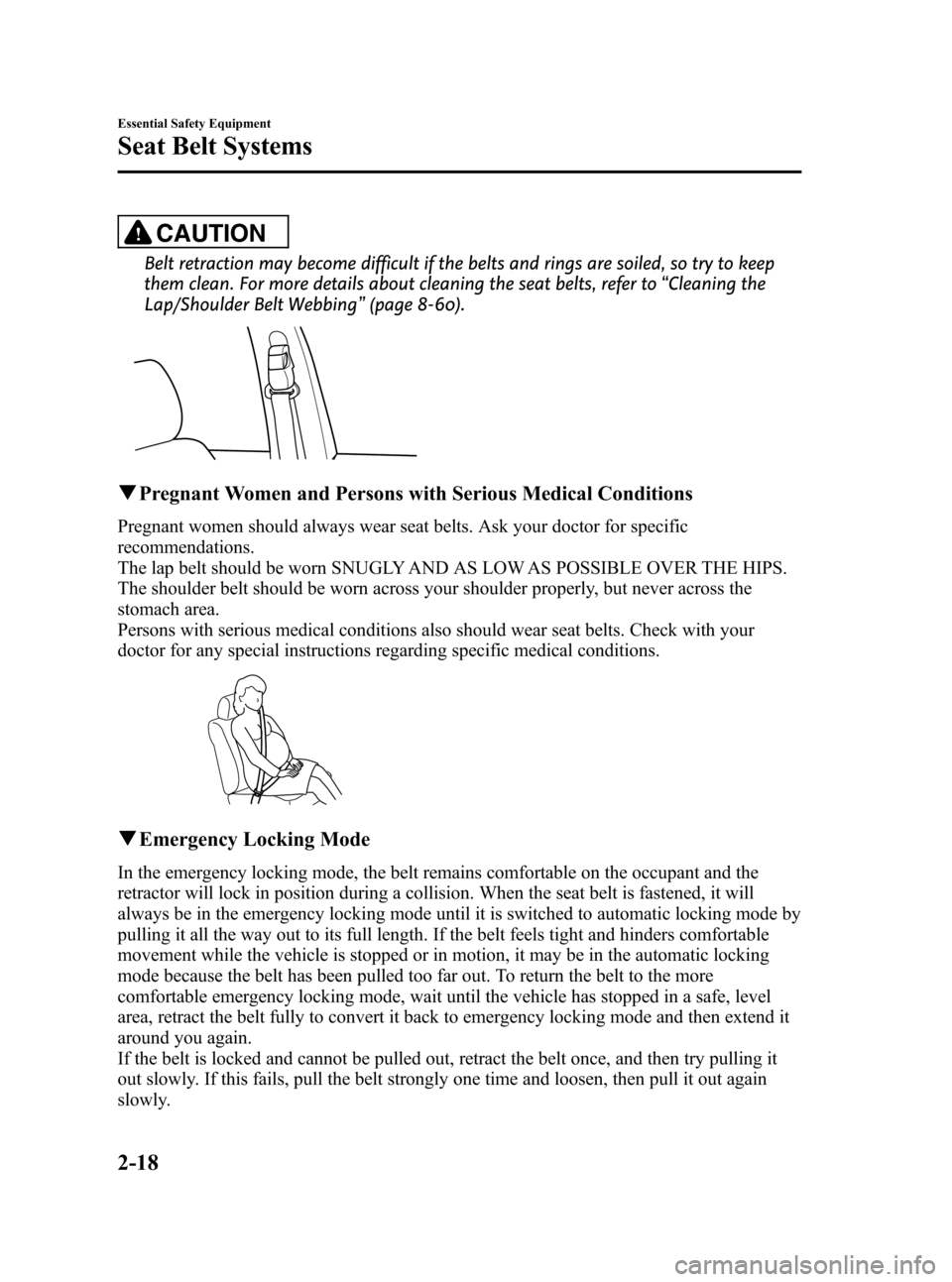
Black plate (32,1)
CAUTION
Belt retraction may become difficult if the belts and rings are soiled, so try to keep
them clean. For more details about cleaning the seat belts, refer to“Cleaning the
Lap/Shoulder Belt Webbing”(page 8-60).
qPregnant Women and Persons with Serious Medical Conditions
Pregnant women should always wear seat belts. Ask your doctor for specific
recommendations.
The lap belt should be worn SNUGLY AND AS LOW AS POSSIBLE OVER THE HIPS.
The shoulder belt should be worn across your shoulder properly, but never across the
stomach area.
Persons with serious medical conditions also should wear seat belts. Check with your
doctor for any special instructions regarding specific medical conditions.
qEmergency Locking Mode
In the emergency locking mode, the belt remains comfortable on the occupant and the
retractor will lock in position during a collision. When the seat belt is fastened, it will
always be in the emergency locking mode until it is switched to automatic locking mode by
pulling it all the way out to its full length. If the belt feels tight and hinders comfortable
movement while the vehicle is stopped or in motion, it may be in the automatic locking
mode because the belt has been pulled too far out. To return the belt to the more
comfortable emergency locking mode, wait until the vehicle has stopped in a safe, level
area, retract the belt fully to convert it back to emergency locking mode and then extend it
around you again.
If the belt is locked and cannot be pulled out, retract the belt once, and then try pulling it
out slowly. If this fails, pull the belt strongly one time and loosen, then pull it out again
slowly.
2-18
Essential Safety Equipment
Seat Belt Systems
Mazda3_8AD6-EC-09A_Edition1 Page32
Tuesday, December 2 2008 2:26 PM
Form No.8AD6-EC-09A
Page 34 of 488
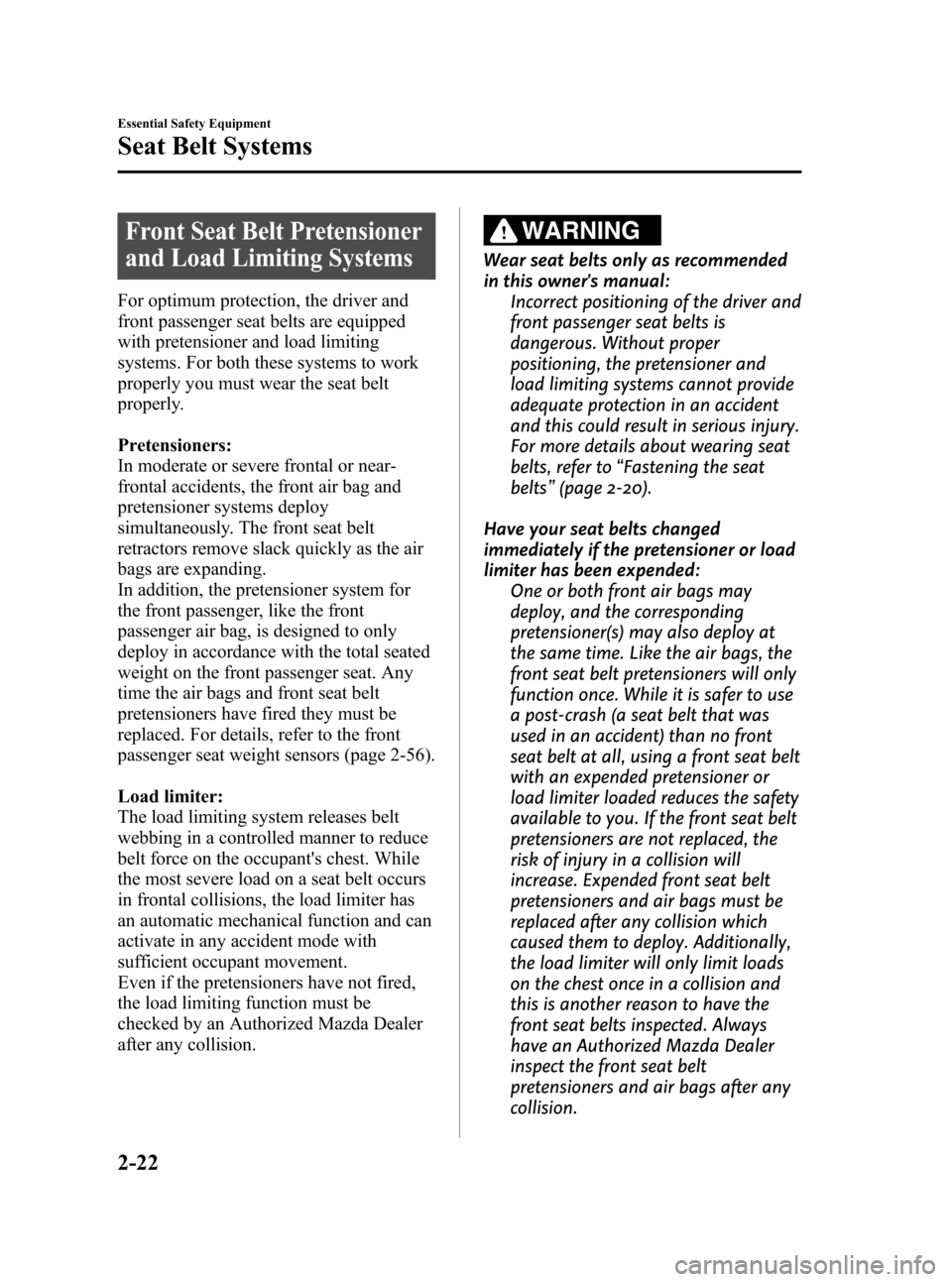
Black plate (36,1)
Front Seat Belt Pretensioner
and Load Limiting Systems
For optimum protection, the driver and
front passenger seat belts are equipped
with pretensioner and load limiting
systems. For both these systems to work
properly you must wear the seat belt
properly.
Pretensioners:
In moderate or severe frontal or near-
frontal accidents, the front air bag and
pretensioner systems deploy
simultaneously. The front seat belt
retractors remove slack quickly as the air
bags are expanding.
In addition, the pretensioner system for
the front passenger, like the front
passenger air bag, is designed to only
deploy in accordance with the total seated
weight on the front passenger seat. Any
time the air bags and front seat belt
pretensioners have fired they must be
replaced. For details, refer to the front
passenger seat weight sensors (page 2-56).
Load limiter:
The load limiting system releases belt
webbing in a controlled manner to reduce
belt force on the occupant's chest. While
the most severe load on a seat belt occurs
in frontal collisions, the load limiter has
an automatic mechanical function and can
activate in any accident mode with
sufficient occupant movement.
Even if the pretensioners have not fired,
the load limiting function must be
checked by an Authorized Mazda Dealer
after any collision.
WARNING
Wear seat belts only as recommended
in this owner's manual:
Incorrect positioning of the driver and
front passenger seat belts is
dangerous. Without proper
positioning, the pretensioner and
load limiting systems cannot provide
adequate protection in an accident
and this could result in serious injury.
For more details about wearing seat
belts, refer to“Fastening the seat
belts”(page 2-20).
Have your seat belts changed
immediately if the pretensioner or load
limiter has been expended:
One or both front air bags may
deploy, and the corresponding
pretensioner(s) may also deploy at
the same time. Like the air bags, the
front seat belt pretensioners will only
function once. While it is safer to use
a post-crash (a seat belt that was
used in an accident) than no front
seat belt at all, using a front seat belt
with an expended pretensioner or
load limiter loaded reduces the safety
available to you. If the front seat belt
pretensioners are not replaced, the
risk of injury in a collision will
increase. Expended front seat belt
pretensioners and air bags must be
replaced after any collision which
caused them to deploy. Additionally,
the load limiter will only limit loads
on the chest once in a collision and
this is another reason to have the
front seat belts inspected. Always
have an Authorized Mazda Dealer
inspect the front seat belt
pretensioners and air bags after any
collision.
2-22
Essential Safety Equipment
Seat Belt Systems
Mazda3_8AD6-EC-09A_Edition1 Page36
Tuesday, December 2 2008 2:26 PM
Form No.8AD6-EC-09A
Page 35 of 488
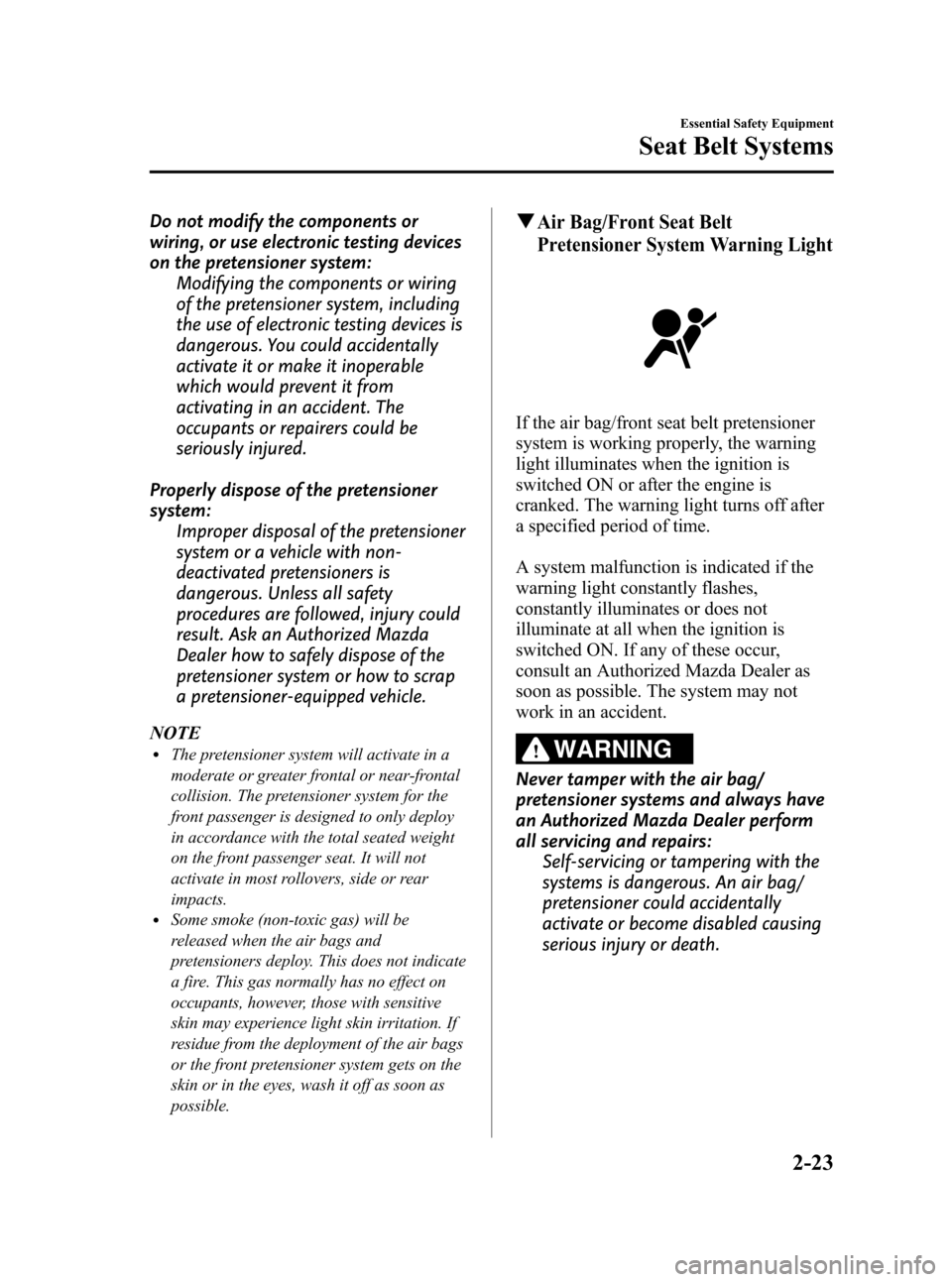
Black plate (37,1)
Do not modify the components or
wiring, or use electronic testing devices
on the pretensioner system:
Modifying the components or wiring
of the pretensioner system, including
the use of electronic testing devices is
dangerous. You could accidentally
activate it or make it inoperable
which would prevent it from
activating in an accident. The
occupants or repairers could be
seriously injured.
Properly dispose of the pretensioner
system:
Improper disposal of the pretensioner
system or a vehicle with non-
deactivated pretensioners is
dangerous. Unless all safety
procedures are followed, injury could
result. Ask an Authorized Mazda
Dealer how to safely dispose of the
pretensioner system or how to scrap
a pretensioner-equipped vehicle.
NOTE
lThe pretensioner system will activate in a
moderate or greater frontal or near-frontal
collision. The pretensioner system for the
front passenger is designed to only deploy
in accordance with the total seated weight
on the front passenger seat. It will not
activate in most rollovers, side or rear
impacts.
lSome smoke (non-toxic gas) will be
released when the air bags and
pretensioners deploy. This does not indicate
a fire. This gas normally has no effect on
occupants, however, those with sensitive
skin may experience light skin irritation. If
residue from the deployment of the air bags
or the front pretensioner system gets on the
skin or in the eyes, wash it off as soon as
possible.
qAir Bag/Front Seat Belt
Pretensioner System Warning Light
If the air bag/front seat belt pretensioner
system is working properly, the warning
light illuminates when the ignition is
switched ON or after the engine is
cranked. The warning light turns off after
a specified period of time.
A system malfunction is indicated if the
warning light constantly flashes,
constantly illuminates or does not
illuminate at all when the ignition is
switched ON. If any of these occur,
consult an Authorized Mazda Dealer as
soon as possible. The system may not
work in an accident.
WARNING
Never tamper with the air bag/
pretensioner systems and always have
an Authorized Mazda Dealer perform
all servicing and repairs:
Self-servicing or tampering with the
systems is dangerous. An air bag/
pretensioner could accidentally
activate or become disabled causing
serious injury or death.
Essential Safety Equipment
Seat Belt Systems
2-23
Mazda3_8AD6-EC-09A_Edition1 Page37
Tuesday, December 2 2008 2:26 PM
Form No.8AD6-EC-09A
Page 44 of 488
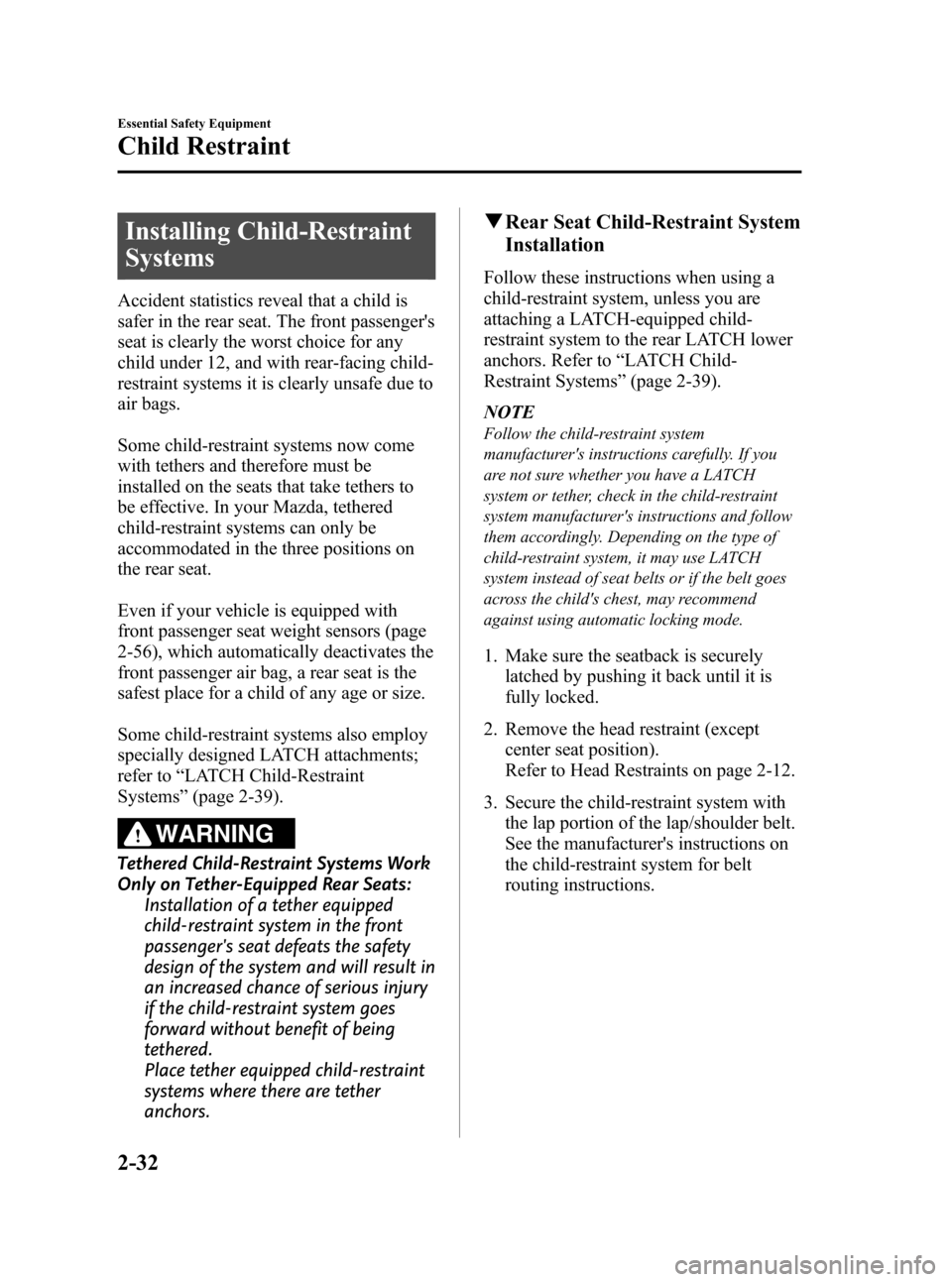
Black plate (46,1)
Installing Child-Restraint
Systems
Accident statistics reveal that a child is
safer in the rear seat. The front passenger's
seat is clearly the worst choice for any
child under 12, and with rear-facing child-
restraint systems it is clearly unsafe due to
air bags.
Some child-restraint systems now come
with tethers and therefore must be
installed on the seats that take tethers to
be effective. In your Mazda, tethered
child-restraint systems can only be
accommodated in the three positions on
the rear seat.
Even if your vehicle is equipped with
front passenger seat weight sensors (page
2-56), which automatically deactivates the
front passenger air bag, a rear seat is the
safest place for a child of any age or size.
Some child-restraint systems also employ
specially designed LATCH attachments;
refer to“LATCH Child-Restraint
Systems”(page 2-39).
WARNING
Tethered Child-Restraint Systems Work
Only on Tether-Equipped Rear Seats:
Installation of a tether equipped
child-restraint system in the front
passenger's seat defeats the safety
design of the system and will result in
an increased chance of serious injury
if the child-restraint system goes
forward without benefit of being
tethered.
Place tether equipped child-restraint
systems where there are tether
anchors.
qRear Seat Child-Restraint System
Installation
Follow these instructions when using a
child-restraint system, unless you are
attaching a LATCH-equipped child-
restraint system to the rear LATCH lower
anchors. Refer to“LATCH Child-
Restraint Systems”(page 2-39).
NOTE
Follow the child-restraint system
manufacturer's instructions carefully. If you
are not sure whether you have a LATCH
system or tether, check in the child-restraint
system manufacturer's instructions and follow
them accordingly. Depending on the type of
child-restraint system, it may use LATCH
system instead of seat belts or if the belt goes
across the child's chest, may recommend
against using automatic locking mode.
1. Make sure the seatback is securely
latched by pushing it back until it is
fully locked.
2. Remove the head restraint (except
center seat position).
Refer to Head Restraints on page 2-12.
3. Secure the child-restraint system with
the lap portion of the lap/shoulder belt.
See the manufacturer's instructions on
the child-restraint system for belt
routing instructions.
2-32
Essential Safety Equipment
Child Restraint
Mazda3_8AD6-EC-09A_Edition1 Page46
Tuesday, December 2 2008 2:26 PM
Form No.8AD6-EC-09A
Page 136 of 488
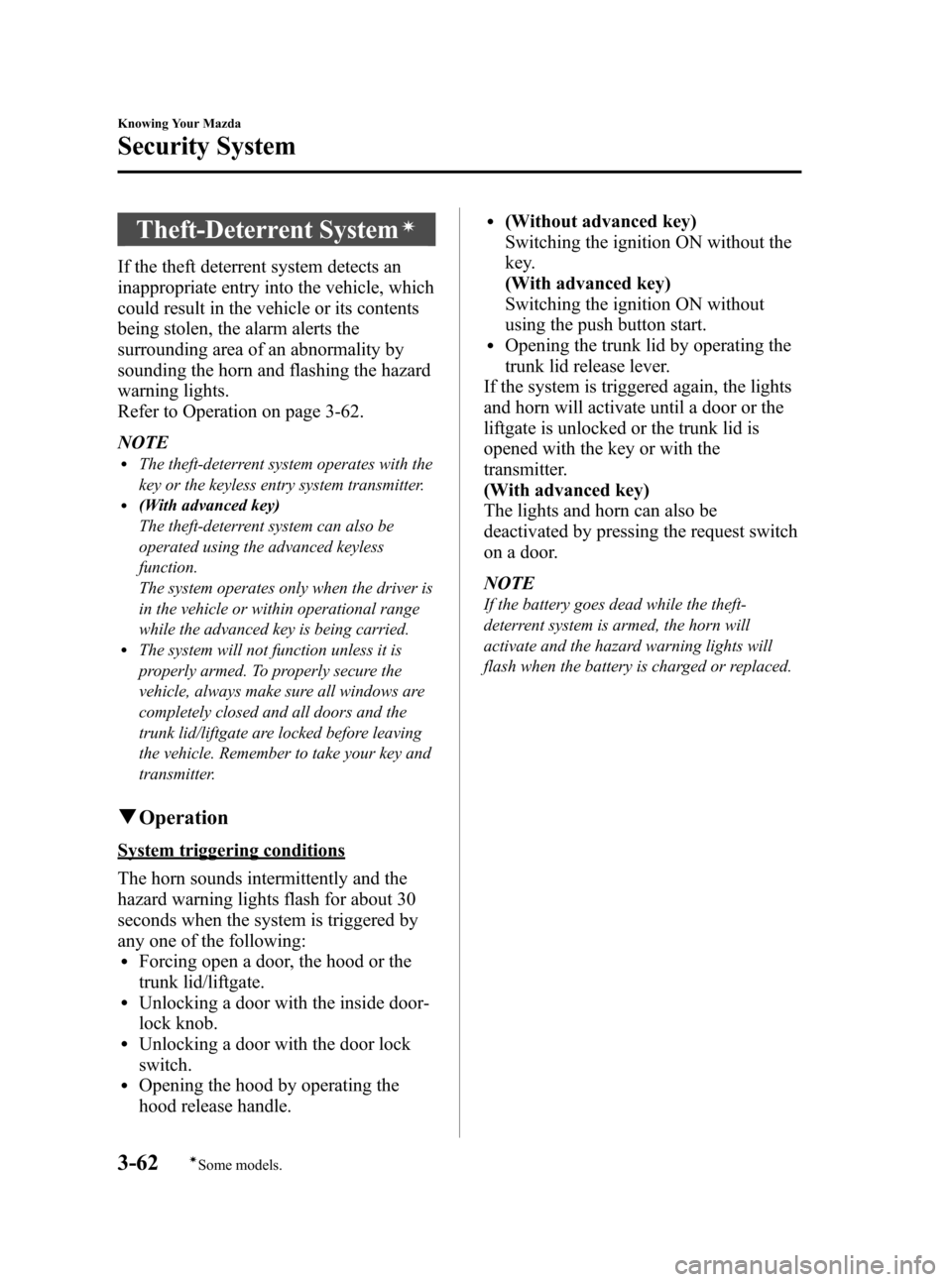
Black plate (138,1)
Theft-Deterrent Systemí
If the theft deterrent system detects an
inappropriate entry into the vehicle, which
could result in the vehicle or its contents
being stolen, the alarm alerts the
surrounding area of an abnormality by
sounding the horn and flashing the hazard
warning lights.
Refer to Operation on page 3-62.
NOTE
lThe theft-deterrent system operates with the
key or the keyless entry system transmitter.
l(With advanced key)
The theft-deterrent system can also be
operated using the advanced keyless
function.
The system operates only when the driver is
in the vehicle or within operational range
while the advanced key is being carried.
lThe system will not function unless it is
properly armed. To properly secure the
vehicle, always make sure all windows are
completely closed and all doors and the
trunk lid/liftgate are locked before leaving
the vehicle. Remember to take your key and
transmitter.
qOperation
System triggering conditions
The horn sounds intermittently and the
hazard warning lights flash for about 30
seconds when the system is triggered by
any one of the following:
lForcing open a door, the hood or the
trunk lid/liftgate.
lUnlocking a door with the inside door-
lock knob.
lUnlocking a door with the door lock
switch.
lOpening the hood by operating the
hood release handle.
l(Without advanced key)
Switching the ignition ON without the
key.
(With advanced key)
Switching the ignition ON without
using the push button start.
lOpening the trunk lid by operating the
trunk lid release lever.
If the system is triggered again, the lights
and horn will activate until a door or the
liftgate is unlocked or the trunk lid is
opened with the key or with the
transmitter.
(With advanced key)
The lights and horn can also be
deactivated by pressing the request switch
on a door.
NOTE
If the battery goes dead while the theft-
deterrent system is armed, the horn will
activate and the hazard warning lights will
flash when the battery is charged or replaced.
3-62
Knowing Your Mazda
íSome models.
Security System
Mazda3_8AD6-EC-09A_Edition1 Page138
Tuesday, December 2 2008 2:27 PM
Form No.8AD6-EC-09A
Page 169 of 488
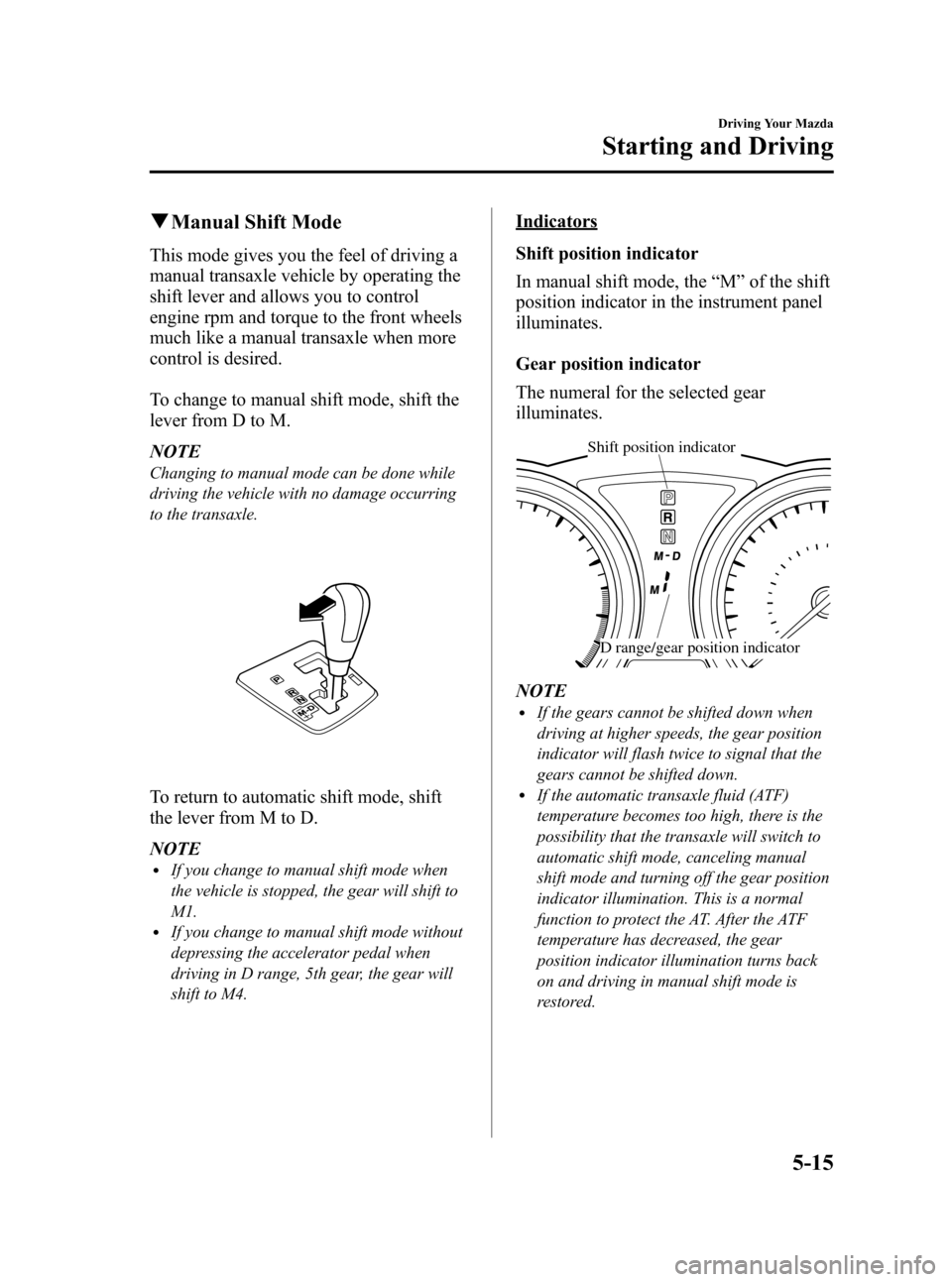
Black plate (171,1)
qManual Shift Mode
This mode gives you the feel of driving a
manual transaxle vehicle by operating the
shift lever and allows you to control
engine rpm and torque to the front wheels
much like a manual transaxle when more
control is desired.
To change to manual shift mode, shift the
lever from D to M.
NOTE
Changing to manual mode can be done while
driving the vehicle with no damage occurring
to the transaxle.
To return to automatic shift mode, shift
the lever from M to D.
NOTE
lIf you change to manual shift mode when
the vehicle is stopped, the gear will shift to
M1.
lIf you change to manual shift mode without
depressing the accelerator pedal when
driving in D range, 5th gear, the gear will
shift to M4.
Indicators
Shift position indicator
In manual shift mode, the“M”of the shift
position indicator in the instrument panel
illuminates.
Gear position indicator
The numeral for the selected gear
illuminates.
Shift position indicator
D range/gear position indicator
NOTElIf the gears cannot be shifted down when
driving at higher speeds, the gear position
indicator will flash twice to signal that the
gears cannot be shifted down.
lIf the automatic transaxle fluid (ATF)
temperature becomes too high, there is the
possibility that the transaxle will switch to
automatic shift mode, canceling manual
shift mode and turning off the gear position
indicator illumination. This is a normal
function to protect the AT. After the ATF
temperature has decreased, the gear
position indicator illumination turns back
on and driving in manual shift mode is
restored.
Driving Your Mazda
Starting and Driving
5-15
Mazda3_8AD6-EC-09A_Edition1 Page171
Tuesday, December 2 2008 2:27 PM
Form No.8AD6-EC-09A
Page 171 of 488
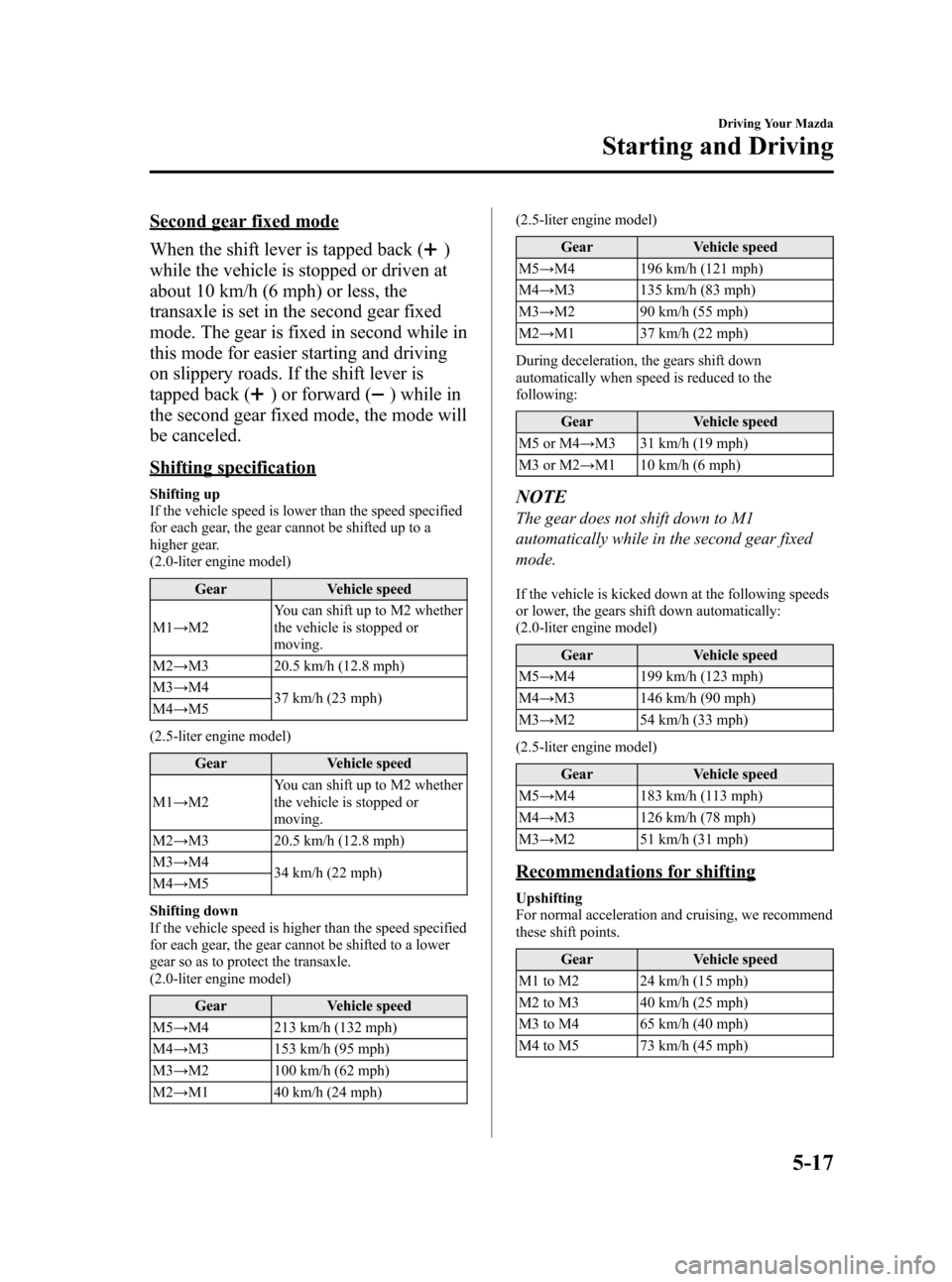
Black plate (173,1)
Second gear fixed mode
When the shift lever is tapped back (
)
while the vehicle is stopped or driven at
about 10 km/h (6 mph) or less, the
transaxle is set in the second gear fixed
mode. The gear is fixed in second while in
this mode for easier starting and driving
on slippery roads. If the shift lever is
tapped back (
) or forward () while in
the second gear fixed mode, the mode will
be canceled.
Shifting specification
Shifting up
If the vehicle speed is lower than the speed specified
for each gear, the gear cannot be shifted up to a
higher gear.
(2.0-liter engine model)
Gear Vehicle speed
M1→M2You can shift up to M2 whether
the vehicle is stopped or
moving.
M2→M3 20.5 km/h (12.8 mph)
M3→M4
37 km/h (23 mph)
M4→M5
(2.5-liter engine model)
Gear Vehicle speed
M1→M2You can shift up to M2 whether
the vehicle is stopped or
moving.
M2→M3 20.5 km/h (12.8 mph)
M3→M4
34 km/h (22 mph)
M4→M5
Shifting down
If the vehicle speed is higher than the speed specified
for each gear, the gear cannot be shifted to a lower
gear so as to protect the transaxle.
(2.0-liter engine model)
Gear Vehicle speed
M5→M4 213 km/h (132 mph)
M4→M3 153 km/h (95 mph)
M3→M2 100 km/h (62 mph)
M2→M1 40 km/h (24 mph)(2.5-liter engine model)
Gear Vehicle speed
M5→M4 196 km/h (121 mph)
M4→M3 135 km/h (83 mph)
M3→M2 90 km/h (55 mph)
M2→M1 37 km/h (22 mph)
During deceleration, the gears shift down
automatically when speed is reduced to the
following:
Gear Vehicle speed
M5 or M4→M3 31 km/h (19 mph)
M3 or M2→M1 10 km/h (6 mph)NOTE
The gear does not shift down to M1
automatically while in the second gear fixed
mode.
If the vehicle is kicked down at the following speeds
or lower, the gears shift down automatically:
(2.0-liter engine model)
Gear Vehicle speed
M5→M4 199 km/h (123 mph)
M4→M3 146 km/h (90 mph)
M3→M2 54 km/h (33 mph)
(2.5-liter engine model)
Gear Vehicle speed
M5→M4 183 km/h (113 mph)
M4→M3 126 km/h (78 mph)
M3→M2 51 km/h (31 mph)
Recommendations for shifting
Upshifting
For normal acceleration and cruising, we recommend
these shift points.
Gear Vehicle speed
M1 to M2 24 km/h (15 mph)
M2 to M3 40 km/h (25 mph)
M3 to M4 65 km/h (40 mph)
M4 to M5 73 km/h (45 mph)
Driving Your Mazda
Starting and Driving
5-17
Mazda3_8AD6-EC-09A_Edition1 Page173
Tuesday, December 2 2008 2:27 PM
Form No.8AD6-EC-09A
Page 179 of 488
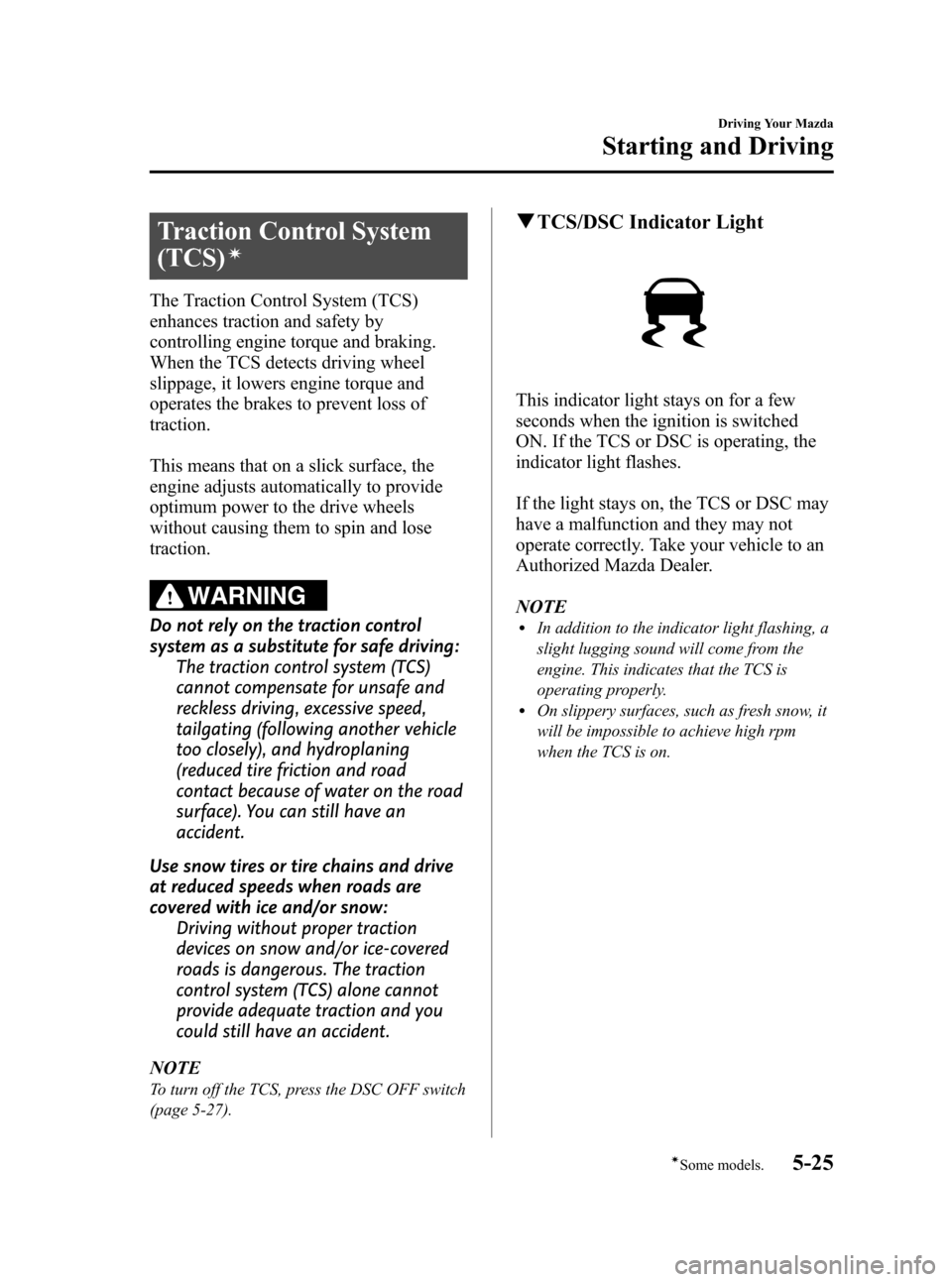
Black plate (181,1)
Traction Control System
(TCS)
í
The Traction Control System (TCS)
enhances traction and safety by
controlling engine torque and braking.
When the TCS detects driving wheel
slippage, it lowers engine torque and
operates the brakes to prevent loss of
traction.
This means that on a slick surface, the
engine adjusts automatically to provide
optimum power to the drive wheels
without causing them to spin and lose
traction.
WARNING
Do not rely on the traction control
system as a substitute for safe driving:
The traction control system (TCS)
cannot compensate for unsafe and
reckless driving, excessive speed,
tailgating (following another vehicle
too closely), and hydroplaning
(reduced tire friction and road
contact because of water on the road
surface). You can still have an
accident.
Use snow tires or tire chains and drive
at reduced speeds when roads are
covered with ice and/or snow:
Driving without proper traction
devices on snow and/or ice-covered
roads is dangerous. The traction
control system (TCS) alone cannot
provide adequate traction and you
could still have an accident.
NOTE
To turn off the TCS, press the DSC OFF switch
(page 5-27).
qTCS/DSC Indicator Light
This indicator light stays on for a few
seconds when the ignition is switched
ON. If the TCS or DSC is operating, the
indicator light flashes.
If the light stays on, the TCS or DSC may
have a malfunction and they may not
operate correctly. Take your vehicle to an
Authorized Mazda Dealer.
NOTE
lIn addition to the indicator light flashing, a
slight lugging sound will come from the
engine. This indicates that the TCS is
operating properly.
lOn slippery surfaces, such as fresh snow, it
will be impossible to achieve high rpm
when the TCS is on.
Driving Your Mazda
Starting and Driving
5-25íSome models. Mazda3_8AD6-EC-09A_Edition1 Page181
Tuesday, December 2 2008 2:27 PM
Form No.8AD6-EC-09A